Ensuring water plants and plantings is one of the concerns of homeowners. Someone watering the beds with vegetables, someone flower beds and lawns, and someone needs to provide water garden. In any case, the procedure takes enough time. But this is not all: in the usual method, it is formed on the surface of the crust, which prevents plants to develop, therefore it has to loosen the soil. All these problems are solved if there is a drip watering of plants. You can buy ready-made sets, order the development and installation of "turnkey" and you can do everything with your own hands. That's how to make drip irrigation yourself and will be discussed in this article.
Principle of operation and varieties
This technology was tested several decades ago. Its results were so impressive that the system was widespread. The main idea is that water is fed to the roots of plants. There are two ways:
- poured on the surface near the stem;
- Served underground into the root formation zone.
The first way is simpler in the installation, the second is more costly: they need a special hose or drip tape for underground styling, a decent volume of land. For a moderate climate, there is no particular difference - both the other way work well. But in the regions with a very hot summer, an underground gasket showed itself: less water evaporates and more by plants.
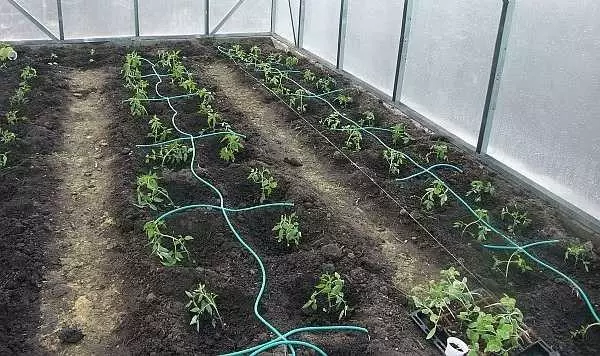
Drip watering is used on the gardens, in the greenhouses. It is most effective when growing vegetables and fruit
There are self-ejecting systems - for them requires a water tank, installed at an altitude of at least 1.5 meters, there are systems with stable pressure. They have a pump and a control group - pressure gauges and valves creating the required effort. There are fully automated drip irrigation systems. In the simplest embodiment, this is a valve with a timer that opens the water supply at a given period of time. More complex systems can control separately consumption for each of the water supply lines, testing the soil moisture and determining the weather. These systems work under the guidance of processors, the modes of operation can be set from the control panel or computer.
Pros and cons
Drip watering has many advantages and all of them meaning:
- The complexity is significantly reduced. The system can be fully automated, but also in the simplest version, irrigation requires literally a few minutes of your attention.
- Reduced water consumption . This is due to the fact that moisture is served only under roots, other zones are excluded.
- Disappears the need for frequent loosening. With a dosage of water supply to a small zone of peel on the soil, it is not formed, accordingly, it does not need to be broken.
- Plants develop better, yield increases. Due to the fact that water is fed into one zone, the root system develops in this place. It has a greater number of thin roots, becomes more lumpy, faster absorbs moisture. All this contributes to rapid growth and more abundant fruiting.
- There is an opportunity to organize a roast feeder . Moreover, the fertilization consumption due to the point feed is also minimal.
The economic efficiency of drip irrigation systems has been proved repeatedly even on an industrial scale. In private greenhouses and gardens, the effect will be no less significant: the cost of creating a system can be reduced to a small amount, and all the advantages will remain.
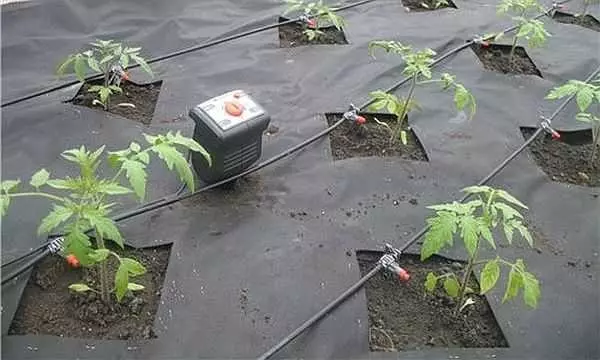
Drip irrigation, assembled with her hands costs not very much
The minuses are also there, but they are quite a bit:
- For normal operation Water filtration is necessary , And these are additional costs. The system can function and without filters, but then it is necessary to consider the purge / washing system to eliminate blockages.
- Droppers eventually clog and require cleaning or replacement.
- If you use thin-walled ribbons, they can be damaged by birds, insects or rodents. There are places of unscheduled water consumption.
- For the device requires the cost of time and money.
- Periodic service required - Throw pipes or clean the droppers, check the hose mount, change the filters.
As you can see, the list of drawbacks is rather big, but they are not very serious. This is a really useful thing in the garden, in the garden, on the lawn, flowerbed or in a greenhouse.
Compounds and layout options
Drip irrigation systems can be organized by any water source. Well, well, well, river, lake, centralized water supply, even rainwater in tanks. The main thing is enough to have enough water.
The main pipeline is connected to the source, which brings water to the watering site. Then he goes on one of the sides of the irrigated area, in the end heavier.
Article on the topic: Wall mural of sports subject: Football and others
Opposite the beds in the pipeline inserted tees, which attach drip hoses (pipes) or ribbons to the side conclusion. They have special droppers through which water is fed to plants.
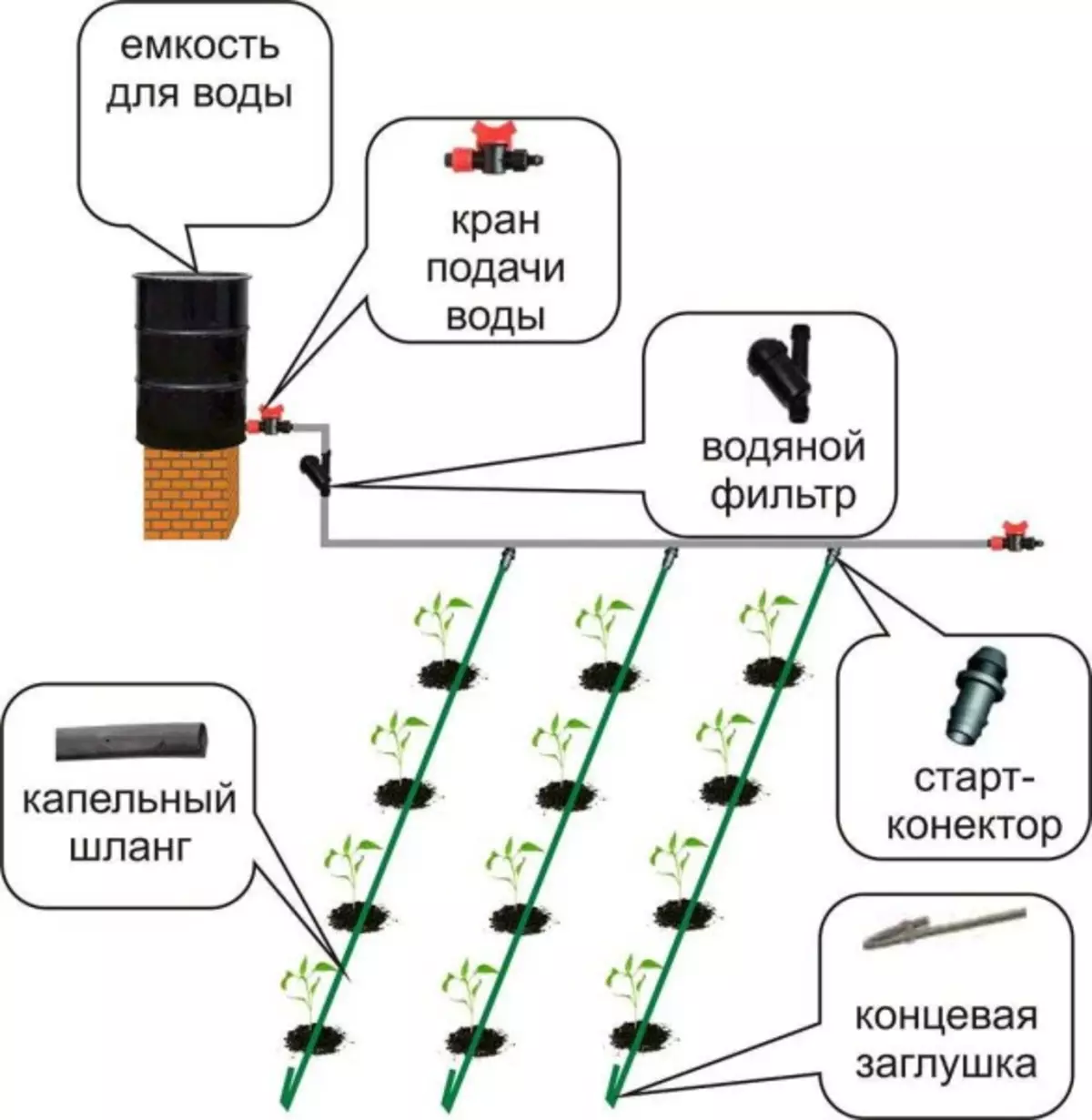
The diagram of drip irrigation from the barrel is easily implemented with their own hands.
Between the output from the source and the first branch, it is desirable to install a filter or filter system. They are not needed if the system is powered by home water pipes. If the water is swinging out of the lake, rivers, rainwater tank, filters are required: contaminants can be a lot and the system will be too often clogged. Types of filters and their number is determined depending on the state of the water.
How to clean the water from the well and the well described here.
Drip hoses
The hoses for drip irrigation are sold in bays from 50 to 1000 meters. They already built water consumption points: labyrinths for which water flows before getting into the outlet. These folded hoses provide the same amount of water all over the line, regardless of the relief. Due to this labyrinth, the flow rate at any point of watering is almost the same.
They differ in the following characteristics:
- Stiffness tube . Drip hoses - are tough, there are soft. Soft are called ribbons, hard - hoses. Hard can be operated up to 10 seasons, soft - up to 3-4. Tapes are:
- Thin-walled - with a wall thickness of 0.1-0.3 mm. They are placed only on the surface, their service life is 1 season.
- Tolstoyed ribbons have a wall of 0.31-0.81 mm, service life - up to 3-4 seasons, there is both ground and underground gasket.
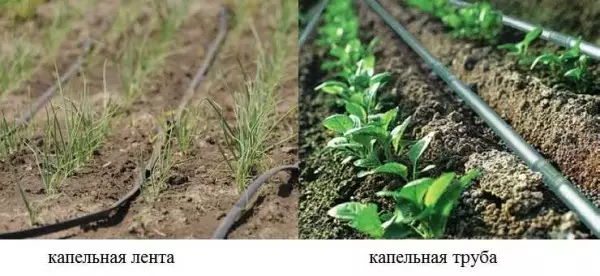
Watering can be organized with ribbons or hoses
- Diameter. Affects productivity and maximum line length. The inner diameter of the hoses can be from 14 to 25 mm, tapes from 12 to 22 mm. Among the ribbons the most common size is 16 mm.
- Water consumption . It is selected depending on the required irrigation intensity. Hoses can produce 0.6-8.0 l / h, thin-walled ribbons - 0.25-2.9 l / h, thick-walled tapes 2.0-8.0 l / h. This flow feature through each dropper.
- Distance between droppers. It can be from 10 to 100 cm. It is chosen depending on the required amount of water and on how often plants are planted.
- Droppers can be with one output or two. The flow of water remains stable. Only the depth and the area on which water is spreading is changing. At one output, the area turns out less, more depth, with two outputs, the area of irrigation increases, the depth decreases.

One or two outputs. Choose depending on the root system of the plant
- Method of laying - Overhead, underground, combined.
- Operating pressure. Changes wide limits depending on the manufacturer: from 0.4 bar to 1.4 bar. You choose depending on whether you have the system, the water supply pumps are used or connected to all to the water supply.
The maximum length of the irrigation line is determined so that the uneven water outlet at the beginning and at the end of the tape did not exceed 10-15%. For hoses, it can be 1,500 meters for tapes - 600 meters. For private use, such values are not in demand, but it is useful to know)).
Dropper
Sometimes it is more convenient to use not tapes, but droppers. These are separate devices that are inserted into the hole in the hose and through which water is supplied under the root of the plant. They can be installed with an arbitrary step - to put several pieces in one place, and then somewhat in the other. It is convenient when drip watering or trees is organized.
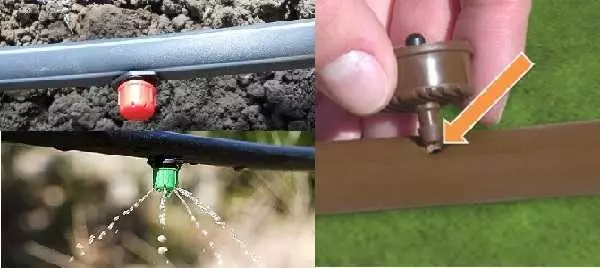
Separate droppers that are installed in the hose is more convenient to use shrubs, grapes and trees when watering
They are two types - with normalized (constant) and adjustable water release. The body is usually plastic, on the one hand there is a fitting, which is inserted into the hole inserted into the hose (sometimes rubber rings are used to seal).
There are also compensated droppers - and noncompensated. When using compensated at any point of watering line, the release of water will be the same (approximately), regardless of the relief and location (at the beginning or at the end of the line).
There are still devices like "Spider". This is when several thin tubes are connected to one output. This makes it possible to simultaneously water several plants from one water outlet point (the number of droppers is reduced).
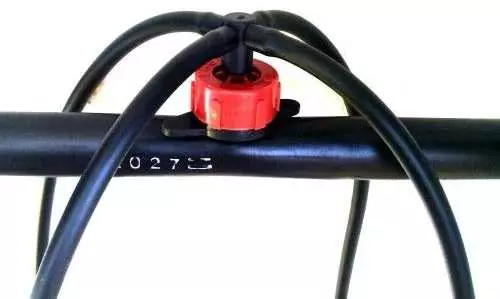
Thumb type dropper - you can water from one point of water distribution several plants
How to make a small greenhouse can be read here. And how beautiful the garden is written here.
Main pipes and fittings
When creating a system for laying a main pipeline from a water source to a watering zone, plastic pipes and fittings are used:
- polypropylene (PPR);
- polyvinyl chloride (PVC);
- Polyethylene:
- high pressure (PVD);
- Low pressure (PND).
All these pipes are well tolerated with water contact, do not corroded, chemically neutral and do not respond to fertilizers. For watering a small greenhouse, a vegetable garden, the lawn is most often used with a diameter of 32 mm.
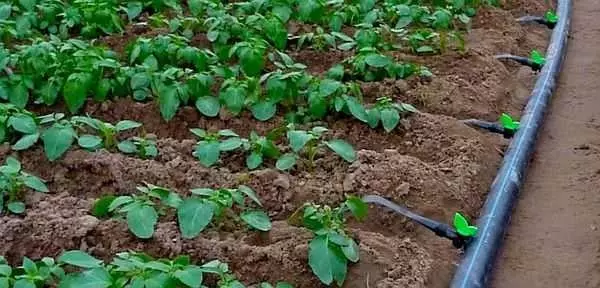
Trunk pipes are plastic. Specifically Type Choose any: PPR, PND, PVD, PVC
In places of removal of lines, tees are installed, the drip hose or tape is connected to the side output. Since they are smaller diameter, you may need adapters, and their outer diameter should be equal to the inner diameter of the hose (or be slightly less). It is possible to mount ribbons / hoses for fittings using metal clamps.
Also, the taps can be made through special fittings, which are installed in the hole done in the hose of the required diameter (as in the photo above).
Sometimes after a tee on each line of distribution of water, a crane is put, which allows you to turn off the lines. It is convenient if the drip watering is divorced on plants moisture and those that do not like excess water.
If you are reluctant to choose the components and select the sizes, the diameters of the fittings, you can buy ready-made sets for drip irrigation from various manufacturers.
Drip irrigation with your own hands: Application examples
The system options are a lot - it is easily adjusted for any conditions. Most often there is a question of how to organize watering independent of electricity. This can be done if you set a sufficient volumetric capacity for water at a height of at least 1.5 meters. This creates a minimum pressure of about 0.2 atm. It is enough for watering a small area of vegetable garden or garden.
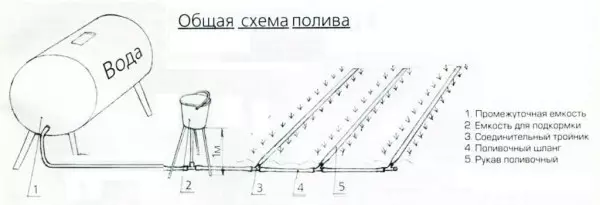
Chart of drip irrigation type
In the capacity, water can be supplied from the water supply system, pump out the pump, merge from the roofs, even poured buckets. In the lower part of the tank make a crane to which the main pipeline is connected. Next, the system is standard: a filter (or cascade of filters) is installed on the pipeline until the first branch, and then there is a layout in beds.
For the convenience of introducing fertilizers to the highway, it is possible to establish a special node. In the simplest case, it is, as in the photo above, it can be a container on the legs, in the bottom of which the hole was done, and the hose is inserted. Also need a locking valve (crane). It is crashed into a pipeline through a tee.
If necessary, you can water and shrubs and fruit trees. The whole difference lies in the fact that the tape or hose is stacked around the trunk at some distance. One line is removed on each tree, the bushes can be watering several pieces on the same line. Only in this case you need to use the usual hose, into which insert droppers with the required water flow.
If small pressure in the system does not suit you, on the main water supply system you can install a pump to increase the pressure (see the photo below) or a full-fledged pumping station. They will provide water even far spaces.
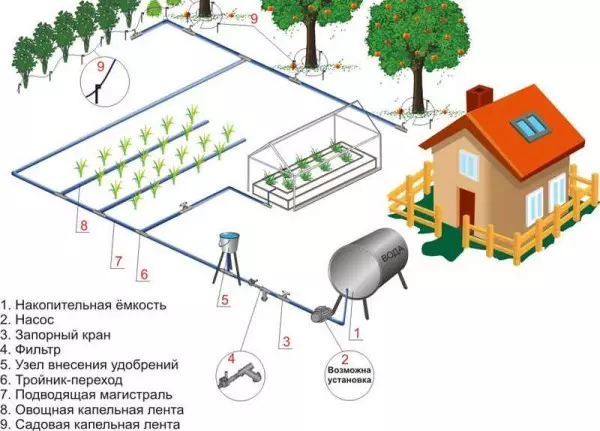
Drop Watering Scheme with Press Enhancement Pump
Is it possible to serve water directly from the source? It is possible, but undesirable. And it is not connected with technical difficulties - they are not so much, but so that the plants are cold water do not like. Therefore, most of the drip irrigation systems of small scales - for greenhouses, vegetable vegetable gardens, gardens and vineyards - use accumulative containers. In them, water is heated, and then divorced by the site.
About how to make high beds to increase yields read here.
Drip watering: how to calculate the system
The container from which water is supplied with the system can be one - general, as in the picture above, or separate on each site. At a considerable distance between irrigation objects, it may be more profitable than pulling the main pipeline.
The required volume is calculated depending on the number of plants and water volume for their normal development. How much water is needed to watering vegetables, depends on climate and soil. On average, you can take 1 liter on one plant, 5 liters per bushes and 10 liters on the trees. But this is the same as the "average temperature in the hospital", although it is suitable for indicative calculations. You consider the number of plants, multiply on the expense per day, everything is summarized. To the resulting digit, add 20-25% of the stock and the required volume of the container you with know.
With the calculation of the length of the highway and drip hoses there are no problems. The highway is the distance from the crane on the tank to the Earth, then on the ground to the place of watering, and there on the end side of the bed. After creating all these lengths, the required length of the main pipeline is obtained. The length of the tubes depends on the length of the bed and on one or two rows from one tube there will be a distribution of water (for example, with the help of dripping-spiders, water can be diluted for two or four rows at the same time).
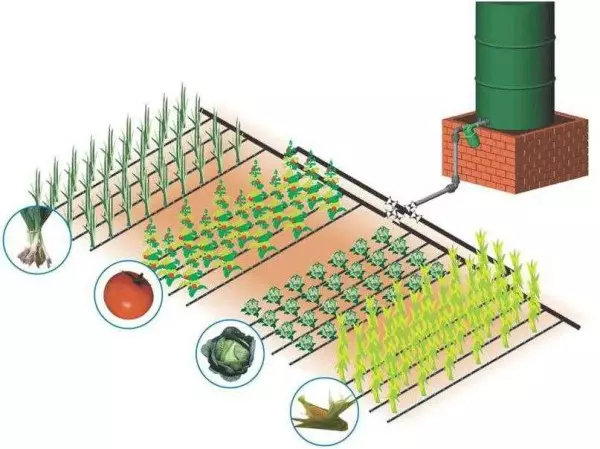
Drip watering with their own hands make it easy:. Schemes for greenhouses and vegetable garden are the same
By the number of tubes, the number of tees or fittings and cranes is determined (if you put them). For each branch using tees, we take three clamps: press the hose to fitting.
The most difficult and expensive part is filters. If water swings from an open source - the lake or river - first the coarse filter is needed - gravel. Then there must be fine filters. Their type and quantity depend on the state of the water. When using water from a well or well, a coarse filter can not be installed: the primary filtering occurs on the suction hose (if the pump station is used). In general, how many cases, so many solutions, but the filters are needed, otherwise droppers will quickly score.
Homemade drip hoses and drops
One of the most significant costs of expenses with an independent device of the system from the finished components is droppers or drip ribbons. Of course, they provide the feed of the same amount of water all over and consumption is stable, but in small areas it is not necessary. You can adjust the feed and consumption of cranes built into the beginning of the watering line. Therefore, there are many ideas that make it possible to make the distribution of water under the plants with the help of ordinary hoses. Look one of them in the video.
This system is difficult to call this drip irrigation. It is rather a bastard watering: the water is tuning under the root, but it works, maybe only a little worse and more suitable for plants with a root system developed inland. This method will be good for trees, fruit shrubs, grapes. They require a significant amount of water, which should go deep into a decent distance and this self-made drip irrigation system can provide it.
In the second video, a really drip watering is organized. This is done with medical droppers. If you have the opportunity to stock such a used material, it will turn out completely cheap.
The amount of water supply is regulated by a wheel. From one hose you can feed water into three and four rows - if you take a sufficient diameter of the hose, you can connect not three devices to it, and more. The length of the tubes from the droppers thoroughly allows you to water two rows on each side. So expenses will really be small.
Droppers can be used almost without reworking. This is if the system was with a bag. Example - in the photo.
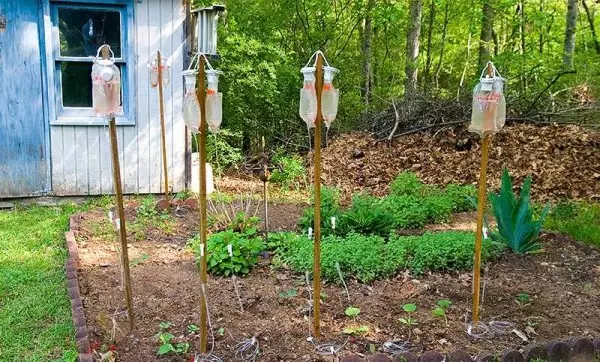
Waste in revenues - watering young plants provided
It is almost also possible to make a drip watering for home plants. It is suitable for those flowers that love constant moisturizing.
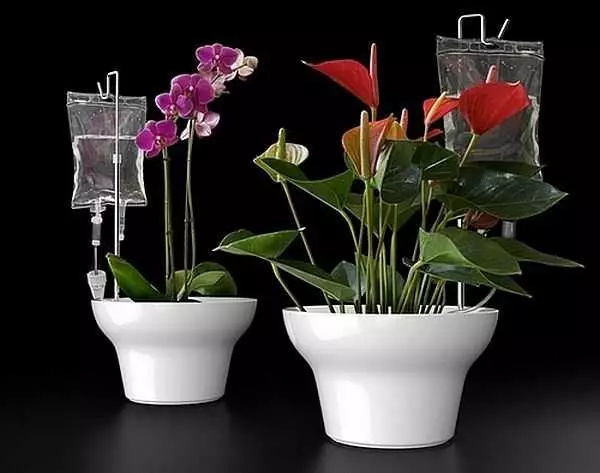
Permanent moisturizing your colors on the balcony? Easily! Watering from dropper
About how to make a pond in the country can be read here. Several species of beautiful and inexpensive tracks can be found here (with recommendations for their manufacture)
The cheapest drip watering: from plastic bottles
There is the cheapest and fast way to organize water supply by plants without hoses and large tanks. We need only plastic bottles and small length - 10-15 cm - thin tubes.
In bottles partially cut off the bottom. So, it turns out from the bottom of the lid. So water will not evaporate. But you can cut off the bottom and completely. At a distance of 7-8 cm from the cover in the bottle, they do a hole in which a thin tube is inserted under a small angle. Bottle to touch the cork down or climb a peg, and peg stick into the ground next to the plant, sending the pipe to the root. If there is in the bottle of water, it runs down on the tube will drip under the plant.
The same design can be done, turning the bottle with a cover up. But this option is less convenient: it is harder to pour water, we need a watering can. What it looks like, look in the figure below.

Drip watering from plastic bottles
As you can see, there is a second version of drip irrigation of plastic bottles. Wire stretches over the garden, bottles are tied to it in the bottom or cover of which the holes are made.
There is another photo-option to use bottles, but with regular droppers for watering. They are fixed on the neck of bottles and in this form are installed under the bush.
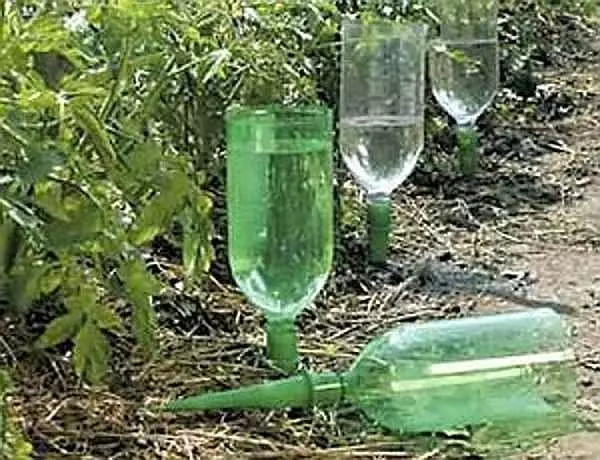
How to make a drip watering at the cottage from bottles
This option, of course, is not ideal, but will give the opportunity to grow better if you can rarely at the dacha. And two liters from the bottle may be decisive in the battle for the harvest.
Article on the topic: Bathroom in Khrushchev: Interior design
